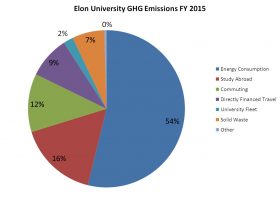Greenhouse gas emissions per square foot of building space have decreased since 2008 while overall emissions have risen.
 The eighth annual Elon University Greenhouse Gas Emissions Inventory has found that emissions per student, and per square foot of building space, are lower than when the university first started tracking its emissions output as part of a long-term goal of reaching carbon neutrality by 2037.
The eighth annual Elon University Greenhouse Gas Emissions Inventory has found that emissions per student, and per square foot of building space, are lower than when the university first started tracking its emissions output as part of a long-term goal of reaching carbon neutrality by 2037.
The per capita figures indicate that school efforts, including the construction of energy-efficient facilities and encouraging sustainable habits, have made a positive impact.
Still, the fiscal year 2015 inventory found that overall greenhouse gas emissions were 17 percent higher than in 2008. The overall increase is primarily due to an increase in energy consumption, university travel and study abroad travel.
Energy consumption is the largest source of emissions, accounting for about 54 percent of emissions. Transportation is the second largest source of emissions at about 37 percent of total emissions.
The increase in energy consumption is likely due to additional square footage and an increase in the number of people using facilities, university officials said. Between fiscal year 2008 and fiscal year 2015, Elon’s total square footage of all campus facilities increased 41 percent, yet emissions per 1,000 square feet decreased 17 percent.
 During this same period, the number of full-time equivalent students increased over 19 percent while emissions per full-time equivalent student decreased 2 percent.
During this same period, the number of full-time equivalent students increased over 19 percent while emissions per full-time equivalent student decreased 2 percent.
Changing cultural views on building space have also impacted energy consumption.
“A building square foot today is not the same as in the past. The needs and expectations are different,” said Gerald Whittington, Elon University’s senior vice president for Business, Finance and Technology. For example, the Global Neighborhood has twice the square footage of the buildings it replaced but the same number of beds, because of the introduction of study rooms, classrooms and food venues.
Transportation includes university travel, study abroad travel, commuter travel and fuel use in the university fleet. The increase in transportation is likely due to more students studying abroad and increased travel due to a change in athletic conferences from the Southern Conference to the Colonial Athletic Association.
The Climate Action Plan outlines a number of strategies for addressing carbon emissions while still meeting the needs of students, faculty and staff. The Sustainability Master Plan, which was updated in spring 2015, includes several objectives that will contribute to emissions reductions such as reducing total energy consumption per gross square foot and increasing the percentage of energy consumption that comes from non-fossil fuel sources, such as solar and geothermal.
 The Office of Sustainability completed the greenhouse gas emissions inventory with the assistance of a student intern. The process involved collecting data from numerous departments, ranging from the Physical Plant for electricity and natural gas consumption to Human Resources for the number of employees. Many departments and individuals on campus contributed information needed to complete the inventory.
The Office of Sustainability completed the greenhouse gas emissions inventory with the assistance of a student intern. The process involved collecting data from numerous departments, ranging from the Physical Plant for electricity and natural gas consumption to Human Resources for the number of employees. Many departments and individuals on campus contributed information needed to complete the inventory.
To learn more about the Greenhouse Gas Emissions Inventory, Elon University’s Sustainability Master Plan or Climate Action Plan, visit the Climate page of the Sustainability website. To learn more about the greenhouse gas emissions summer internship, email sustainability@elon.edu.
To learn more about conversations concerning greenhouse gas emissions on an international scale read about the United Nations Conference on Climate Change in Paris.
– Information submitted by Jessica Bilecki in the Office of Sustainability


